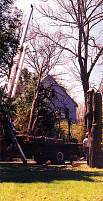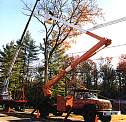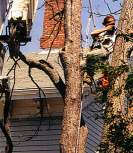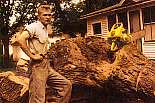Reproduced from Arbor Age magazine, September 1997
Big Tree Takedown
Bringin' 'Em Down
By Nancy Sappington
When a youthful George Washington chopped down the cherry tree, he got into trouble because he did it without permission. He was also foolish in another respect. Washington probably had little experience taking down trees, especially big trees, and it takes a lot of experience to take down big trees successfully.
The ultimate decision to take down a tree lies with the client, but it is up to the arborist to provide the client with the proper information with which to make that decision.
Tim Jackson, who does national recruiting and training for the Davey Tree Expert Company in Kent, Ohio, says that it's time to recommend a tree removal when the tree has become a hazard. For instance, if the trunk of a tree is over 30 percent decayed, removal should be considered. "Every time we cut down a tree we lose a customer," says Jackson. Whenever possible he tries to work with the tree to save it.

|
This limb is being
positioned so it can be lowered safely to the ground Photo courtesy: D.J. Snyder |
Recognizing Hazard Trees
Learning about individual tree species and being
familiar their growth patterns helps you to determine whether a particular
tree presents a hazard. With this understanding you can recognize damaged
crowns, cracks or leans in tree trunks, basal root problems or poor
orientation. Then you can evaluate and determine if the tree can be
saved by some mechanical means such as cabling and bracing or if it
really needs to come down.

This 65-foot lift with a two-man bucket helps to make hazardous tree removal more efficient and safer. Photo courtesy The Asplundh Tree Expert Company.
Knowing your trees will also help you to anticipate how the tree will react during the takedown process. Determining the type of wood from a particular tree, i.e., soft or hard, is critical for a smooth operation. It's necessary to be able to estimate the weight of a tree in order to choose the right equipment for the job.

An old plantation in Louisiana looses
an oak.
Photo by Albin P. Dearing V, The Davey Tree Expert Company.

Working in tight quarters presents many safety
challenges.
Photo courtesy: D.J. Snyder.
Plan Ahead
A tree that is leaning precariously over a rooftop,
especially a neighbor's, presents a liability problem. But swinging
large pieces of wood about a heavily trafficked area also should be
cause for concern.
A successful tree takedown may seem to go quickly and smoothly, but be assured there is a lot of analysis, preparation and rehearsal before the event takes place.
Manually climbing a tree and taking it down is more time-consuming than using a crane and bucket. But with heavy equipment comes costly overhead. Also, the location of the tree will help you determine what equipment you use. Donald Blair states in his book, Arborist Equipment, "Considering the fact that many of our largest trees are now living and dying in backyards, the options of a crane, aerial lift and free falling are not available. We have to take these trees on their own ground with what we can carry through a 30-inch gate."
For manual takedowns there is an array of equipment available -- pulleys, blocks, ropes and lowering devices to name a few. When you make your equipment selections, it is paramount that you fully understand the factors that affect the strength and performance of the equipment.
After making proper equipment selections, a coordinated, team-effort is the next thing to strive for. Jackson holds job briefings with his crew. This gives the foreman and the crew an opportunity to look at the tree and discuss how to bring it down.

A climber reties to a different position to prepare for the removal of another large piece. Photo courtesy: D.J. Snyder
D.J. Snyder, owner of the D.J. Snyder Company in Newtonville, Massachusetts, also holds team meetings before starting projects. Snyder mostly uses his 12.5-ton crane with a 95-foot boom to do takedowns. The preliminary meetings he holds are important for determining the position of equipment and for doing safety checks.
Snyder, who has been taking trees down since 1982 and apprenticed two years prior to that, has developed a management technique that wins him cooperation from the group. He stresses the positive, not the negative. "We should say what we should do as opposed to saying what not to do," he says.

